- Home
- Injections
- Laser Treatments
- Specialties
Specialtiesview all
- Other Treatments
- Before After Photos
Before After Photosview all
- Contact Us
- Doctor And Staff
- About Celibre
- Blogs
If you’re thinking about having a laser or IPL treatment, then we have no doubt that you’ve come across both these terms and asked yourself – “What’s the difference between laser and IPL?” It’s one that we hear in our office every day!
First, it’s important to explain the differences between lasers and IPLs. They are commonly lumped together, but the reality is that they are apples and oranges. If you understand their differences, it will help you better decide which is the better treatment to help you with your particular problem.

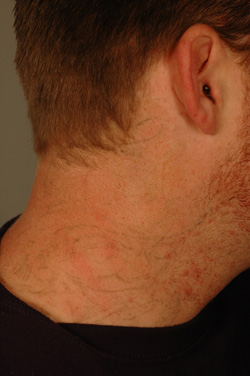 Laser is an acronym for Light Amplification by Stimulated Emission of Radiation. Lasers work by taking one, single wavelength of light and multiplying it, making it more powerful. Each laser has a unique energy source that produces a very specific wavelength of light. This essentially means that each laser is very good at treating only a specific problem.
Laser is an acronym for Light Amplification by Stimulated Emission of Radiation. Lasers work by taking one, single wavelength of light and multiplying it, making it more powerful. Each laser has a unique energy source that produces a very specific wavelength of light. This essentially means that each laser is very good at treating only a specific problem.
A laser with a wavelength of 595 nm (nanometers) effectively treats conditions involving excess blood vessels as hemoglobin in red blood cells specifically absorbs this wavelength of light. However, it cannot treat pigmentation issues or rejuvenate the skin or reduce wrinkles. Lasers are highly specific and generally good at treating a single type of skin problem.
IPL stands for Intense Pulsed Light. These devices use a range or many different wavelengths of light. Because of this, they can treat a few different, unrelated skin problems. Many people choose IPL treatment for generalized sun damage because the light generated by IPLs includes wavelengths for both blood vessels/redness and pigmentation (sun spots), making it effective for both concerns.
So, why wouldn’t you just use IPL for everything? IPL, although versatile, lacks the ability to generate sufficient energy for treating tough skin conditions like tattoos, hair removal, and red and brown birthmarks. In contrast, lasers surpass IPLs as they can be adjusted to deliver a more powerful single wavelength of light.
Another factor is that some lasers can be used to treat any and all skin types (colors). Generally, because of the array of wavelengths in IPL, it is not as safe option for medium and dark skin types as lasers. Asians, Hispanics, East Indian and African Americans can end up with skin blistering and burns after IPL treatments.
Because most laser centers have and offer both types of treatments, many people assume they are the same. Nothing is further from the truth. In fact, you should ask questions about which devices a practice uses for your skin type before you sign up for treatment. One that offers IPL for everything may not be the one that you want to choose.
At Celibre Medical, we offer more than 10 different class IV medical lasers for a variety of skin conditions. We believe that this allows us the superior ability to safely and effectively treat almost any skin condition in any skin color. While we also have and offer IPL, we only use it when it’s the safest and most effective treatment option for you.
The role of lasers for acne treatment is twofold. First, lasers kill acne bacteria. Without bacteria, acne lesions cannot form. P.acne bacteria is naturally occurring in the skin and by using heat energy from lasers, acne bacteria is controlled. It is important to realize that controlling acne bacteria is only a temporary solution for controlling acne, and acne bacteria can and may return in a short time. Because acne bacteria are naturally occurring in the skin, any solution for controlling acne by killing acne bacteria (like antibiotics, blu-u light treatments or topical creams) will need to be repeated often to control the acne.

A longer term benefit of laser acne treatment is the control of the amount of oil produced by the sebaceous (oil) gland. By controlling and limiting the amount of excess oil produced by the sebaceous gland, it is less likely that future acne will form. Excess oil contributes to blocked pores and this in turn leads to acne lesions. Using lasers, it is possible to shrink the sebaceous gland so that it does not produce as much oil in the future and therefore leads to less acne. Although the amount of oil production after laser treatment varies from patient to patient, we find that using lasers allows us to achieve a significant reduction in the amount of active acne for between 70% and 80% of patients we see.
If you’re seeing spots, it may be time to see a doctor. We’re not talking about an eye specialist, but a skin and laser practitioner. Many people mistakenly think that they develop spots on their skin (age spots, sun spots, freckles, moles, liver spots, etc.) only when they get older. The truth is that the sun damage and exposure from years past, even childhood, can show up as unwanted brown spots on your skin as an adult.
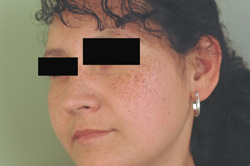
 So, what can help? Class IV medical lasers are an extremely effective way to get rid of unwanted age spots because they can specifically target the melanin or pigmented cells within them. If you’ve noticed a change in the quality of your skin (rougher, thicker , etc.) along with your spots, you’re not dreaming. These changes often accompany the appearance of spots due to years of accumulated UV damage. Fortunately, Class IV medical lasers can stimulate the production of new collagen which can dramatically improve overall texture and tightness.
So, what can help? Class IV medical lasers are an extremely effective way to get rid of unwanted age spots because they can specifically target the melanin or pigmented cells within them. If you’ve noticed a change in the quality of your skin (rougher, thicker , etc.) along with your spots, you’re not dreaming. These changes often accompany the appearance of spots due to years of accumulated UV damage. Fortunately, Class IV medical lasers can stimulate the production of new collagen which can dramatically improve overall texture and tightness.
Laser treatments for these conditions are relatively quick and painless—usually around 30 minutes. Best of all, they have a limited recovery, so you can get right back to your life afterward. Our q-switched lasers for brown spots are safe for all skin types (colors) so anyone is a candidate for treatment.
If you’re tired of seeing spots, come and see us today. We’ll not only help your skin look clearer, but we can help it look smoother and tighter too.
Sun spot removal before and after pictures
Having embarrassing spider veins on your legs can really affect your life. They may keep you from wearing the clothes you love or from going to the gym or pool. Many patients like you suffer with spider veins. And no matter what kind of physical shape you’re in, genetics and previous pregnancies are often the main culprits for their development.
If you’re thinking about getting rid of your spider veins, then you’ve probably read about laser and injection treatment options and wonder which one might be best for you? We’ve had many of our own patients come in asking the same question, so we wanted to share our insights with you.
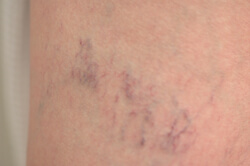
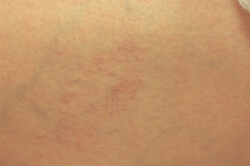 Both injections and lasers can work well for the removal of leg veins. However, they are not always interchangeable, because they target different sized blood vessels. Remember that spider veins happen when deeper and larger leg veins develop faulty one-way valves. This allows the blood to “back up”, which fills the smaller veins near the skin’s surface making them visible. Most people with spider veins have a mix of both larger and smaller leg veins.
Both injections and lasers can work well for the removal of leg veins. However, they are not always interchangeable, because they target different sized blood vessels. Remember that spider veins happen when deeper and larger leg veins develop faulty one-way valves. This allows the blood to “back up”, which fills the smaller veins near the skin’s surface making them visible. Most people with spider veins have a mix of both larger and smaller leg veins.
Laser therapy involves the use of heat energy to target the hemoglobin in the blood within the spider vein. This heats up the entire vein, coagulating and clotting the blood inside it, collapsing the vessel walls and seals it off. Once it’s no longer a functioning vein, the body breaks it down and removes it.
Sclerotherapy is a bit different. It involves the direct injection of a detergent-like solution into the unwanted vein. This solution damages the inner lining of the vessel wall by dehydrating it. This causes the entire blood vessel to harden or “sclerose” which makes it unusable by the body. It too eventually is broken down and removed.
We’d also like to mention that sclerotherapy carries the potential for a couple of unwanted side effects that laser treatment does not. First, when red blood cells from the treated vessels leak out and into the surrounding skin, it can cause “staining”. Hemosiderin staining is a brownish discoloration that persists in the treated areas as residual iron from the blood cells remains (sometimes for years) after the rest of the blood cell and vessel has broken down and been removed. While there are different laser treatments that can help remove it, many people feel that staining after sclerotherapy looks worse and is harder to get rid of than the spider veins themselves.
Another phenomenon we’ve seen after sclerotherapy is matting. Matting is the appearance of a “mat” of new, fine blood vessels just next to the treated area. This happens as the blood can no longer get through the hardened veins and looks to make its way into other, surrounding blood vessels.
This brings us (finally!) to an answer to the title question of this page: it depends! Some people will need both treatments. Here at Celibre Medical, we generally use sclerotherapy for larger or “feeder” veins (called reticular vessels) and laser for matting or fine veins that we can’t inject into easily. An experienced sclerotherapy provider who understands the ins and outs of treatment well will usually perform and recommend both treatments at their practice.
If you’re not sure if laser, sclerotherapy or both are right for you, we can help! Our experienced providers can evaluate you and tailor a treatment plan that best fits your legs to get them looking great in no time.
Have you ever looked closely at a child’s skin? It’s perfectly smooth, taut and rarely can you see the individual pores. An adult’s skin—especially someone past the age of 40 or 50—well, let’s just say it’s a different story. Time takes its toll on us, most notably on our facial skin. Why? Because your face is exposed to more environmental damage than most other areas of the body.
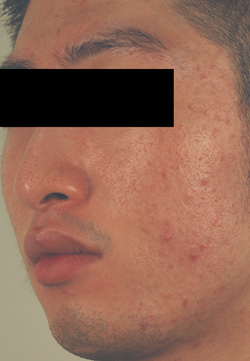
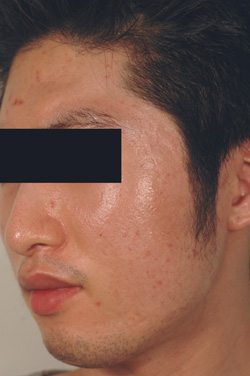 As we age, we lose the critical structures in our skin’s connective tissue layer that make it tight, firm and smooth: collagen and elastin. Sun damage accelerates this process and the result is skin that is lax and loose which tends to enlarge pores and make them more visible. This is compounded in areas where we’ve got lots of oil glands – the nose, forehead and inner part of the cheeks.
As we age, we lose the critical structures in our skin’s connective tissue layer that make it tight, firm and smooth: collagen and elastin. Sun damage accelerates this process and the result is skin that is lax and loose which tends to enlarge pores and make them more visible. This is compounded in areas where we’ve got lots of oil glands – the nose, forehead and inner part of the cheeks.
It’s interesting that people buy skin care products that claim to “tighten” and “shrink” pore size. While it’s true that you can temporarily see a tightening of pores after you use an astringent or exfoliate (remove/thin the very outer skin layer), these are just temporary measures; they can’t physically change the size of your pores.
Class IV medical lasers however, can work in more permanent ways to tighten and firm your skin while decreasing pore size. One way they do this is by targeting the oil glands themselves. When thermal energy is absorbed into the oil gland during a laser treatment, it can shrink and produce less oil. This helps your complexion in many ways, and can create smoother-looking skin.
Another way lasers work to reduce pore size is to build more collagen. There are a couple different lasers to do this, but the net effect is similar: more collagen means a thicker dermis (middle layer of skin) which makes your skin tighter and younger looking. This in turn, reduces your pore size and contributes to overall rejuvenation of your skin.
At Celibre Medical, we will often recommend a combination approach that uses both good, medical-grade skin care along with Class IV medical lasers. Over the years, we’ve found that this combination gives our patients the most lasting and beautiful results that they’re looking for when it comes to taming unwanted, enlarged pores.
For most adults, acne is a teenage problem. Acne was a nuisance for sure, but not much more than a memory. But maybe you still have acne and feel differently—a lot differently. Do you think about your acne constantly? Do you stay away from social or work situations because of unexpected breakouts? Do you feel trapped in an cycle of irritating, ineffective and expensive acne medications that don’t work for you?
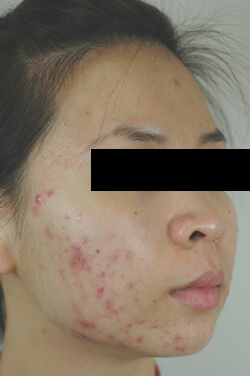
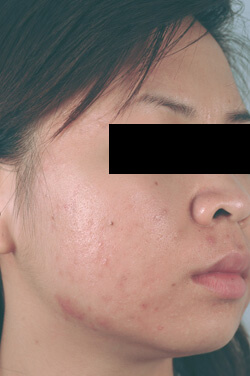 One thing about acne that we know for sure is that it affects everyone differently. It can be a devastating problem that leaves both emotional and physical scars. Even the mildest acne can be devastating to some. We understand this and respect it. We also know that there is no “cure” for acne.
One thing about acne that we know for sure is that it affects everyone differently. It can be a devastating problem that leaves both emotional and physical scars. Even the mildest acne can be devastating to some. We understand this and respect it. We also know that there is no “cure” for acne.
At Celibre Medical, we’re passionate about helping our acne patients. We truly understand the impact it can have on your life and have spent countless hours listening to our patients tell us about their daily struggles.
Our patients often have a “breaking point” or turning moment when they realize they have to find something that works. Maybe it’s a birthday, wedding, prom or some other special event that motivates them to seek out a different treatment path. Are you at this point? Do you feel hopeless about your skin and ready to give up? We want you to know that we are here to listen to you and to help! There is hope and there are effective treatments that can make your acne better.
Celibre Medical takes a different approach to acne. We base all our treatment recommendations on research-proven and clinically effective devices and practices that are reported in the medical literature. You won’t find any trendy, hip, or unproven acne treatments here. Our promise to you is to use and recommend treatments that have a solid track record of success.
We want you to understand your acne better as well as how the treatment recommendations can help. We can’t cure it or make it disappear overnight, but together, we can make your acne more manageable and less impactful on your life and well-being.
This is a question that we hear daily from patients like you. Although you might think we get tired of giving the same answer over and over, we don’t. Our goal is to provide our patients with the most accurate, up-to-date information about the conditions we treat and procedures we perform. We never tire of helping patients like you choose effective, life-changing treatments that suit their preferences, lifestyles and budgets! All that to say our answer is yes; however, there are a few factors that must be considered:

Experience of the laser practitioner: We’re not just talking about credentials here. In many U.S. states and countries around the world even, aestheticians and “laser technicians” can perform laser hair removal. And trust us when we say that a licensed MD can injure, burn or even scar a patient with a laser just as easily as someone with far less formal education under their belt. The key is: what is their laser hair removal experience. The more laser procedures someone has performed, the more familiar they are with the skin’s reaction to the laser, the settings that are necessary and the clinical judgement needed to do a safe and effective job. In our opinion, someone with a solid year of laser hair removal experience will likely have a well-rounded, real-world education with their device to be able to deliver safe and effective results.
Training: Laser training shouldn’t begin and continue with unsuspecting patients. Unfortunately, some laser practitioners get very little training. We believe that at a minimum, training should include at least eight hours of supervised work that includes use of the laser on multiple different patients with varying skin types (colors) for a practitioner to have a basic skill set. Ask before you let someone treat you. Ideally, someone with at least two years of laser hair removal experience themselves, employed or affiliated with a different, external facility, should train your practitioner.
Laser technology: While you might think that there lots of different lasers used for laser hair removal, there are only four different devices. The diode laser (810 nanometer wavelength), the alexandrite laser (755 nanometer wavelength) and the Nd:Yag (1,064 nanometer wavelength) are the top three laser choices. The fourth is an Intense Pulsed Light device, or IPL. We consider the first three to all be effective and safe options for permanent laser hair removal. The IPL is less so (although it is commonly used) because it isn’t really a laser. IPLs use multiple wavelengths of light, instead of just one and have a harder time getting rid of medium and fine hair.
The 755 nm, 810 nm, and 1064 nm lasers provide targeted treatment for the melanin lining the hair follicles. These three wavelengths of light are designed to absorb hair, enabling the laser’s energy to selectively damage the follicle while leaving the skin unharmed.With an IPL, there are multiple wavelengths of light that go into the skin. In order for the ones that damage melanin in the follicle to be powerful enough, you have to increase the overall energy of the treatment. This significantly increases the risk of unwanted side effects and does not guarantee that the follicle will sustain enough damage for permanent hair removal. That’s right. With IPL, you increase the risk of unwanted side effects without getting the permanent hair removal you want. This is why we do not recommend IPL for permanent hair removal.
You may wonder why there are three other wavelengths used then? The answer is that each wavelength is best suited for unwanted hair on different skin types (colors). The diode (810 nm) and alexandrite (755 nm) work well on lighter skin types—Scandinavian up to some Asian or Hispanic heritages. The Nd:Yag (1064 nm) is ideally suited for darker skin types, such as African and African-American.
Choosing a facility to provide safe laser hair removal
Often practices that use IPL can do treatments very quickly because of the size of the laser head. This means IPL treatments are often cheaper. The problem lies in the fact that IPL cannot achieve the same high percentage of permanent hair removal. Consequently, in the end, many patients have to undergo repeat laser hair removal treatments if they had previously used IPL. Try to find a practice that offers laser treatments for your skin type to maximize the chance of getting a good result.
Other practices may offer very little laser training for nurses or rely on other staff to train new employees because it’s convenient and free. Unfortunately, practices that skimp on training and use a one-size-fits all approach may not have the experience or ability to customize treatment settings that are right for you. All this amounts to an increased risk of side effects and/or ineffective treatments.
Make sure your laser hair removal practice has a device that’s appropriate and safe for your skin type. Ask what kind of training your laser practitioner has and how many treatments he/she has performed in the past. Lastly, make sure you are a part of your treatment plan. A facility that doesn’t take the time to educate you on your condition and explain the treatment process likely cares very little for your safety and satisfaction.
While it may a bit more work for you up front, finding the right office for laser hair removal is worth it in the end.
Class IV medical lasers are devices specifically designed to emit various wavelengths of light (visible and non-visible) to treat many different medical conditions. They are the highest-powered type of laser used in medicine and have the potential to cause damage to the skin and eyes if used incorrectly. In the state of California, only licensed physicians, physician assistants, nurse practitioners or registered nurses may legally operate Class IV medical lasers.
Each laser is designed to emit a single wavelength of light that generates powerful thermal energy for an intended target (i.e. hair, blood vessels, pigment/melanin). Because of this, not all lasers can treat the same condition. Each one has a very specific and specialized purpose. However, there are several lasers that can treat a wide range of skin problems because they use multiple wavelengths of light.
As an example, hemoglobin is a molecule that attaches to and carries oxygen in red blood cells. Lasers that target hemoglobin can be used to treat skin problems that involve unwanted blood vessels like rosacea, red acne scars, angiomas or spider veins. Other lasers are specific for pigment or melanin. These devices are used to treat tattoos, unwanted hair (pigment lines the follicle), sun spots, age spots and other skin pigment problems. Lastly, some devices target water. These lasers vaporize skin and can be used to resurface and regenerate large or small areas of skin, depending on the desired effect or the outcome that’s wanted. Acne scars, wrinkles and texture issues (pores) are treated with this type of laser.
At Celibre Medical, we use a variety of different lasers. Some of the lasers we use include: the Lumenis LightSheer, the Sciton Profile, the Cynosure V-Star, the Candela V-Beam, the Quantel Medical Aramis, the Laserscope Lyra, the Palomar Q-Yag V, and the Hoya Conbio Medlite C6 to name a few. If you’d like to learn more about our laser equipment and the skin conditions they treat, please visit celibre.com/equipment.


You may have heard of or read the term “frosting” when researching laser treatment for age spots, tattoos, or brown birthmarks and thought, “that sounds strange?” And while “frosting” typically conjures up visions of birthday celebrations or winter windshields, in the laser world, it’s a term that we use to describe what we see happening in the skin as it’s treated with a q-switched laser. It has nothing to do with dessert or freezing and everything to do with appearance. When we see a thin, white layer or “frost” on skin that’s just been treated with laser, we know we’re in the sweet spot—no pun intended! Let us explain a bit further.
A q-switched laser uses a powerful beam of light energy. That delivers both heat and a sound wave to its target, physically breaking apart pigment. In the case of tattoos, age spots, or brown birthmarks, this target is melanin or pigment in the skin. As melanin is broken up, the process creates a reaction of sorts that triggers the release of gas that becomes trapped beneath the skin’s surface. This trapped gas looks like a layer of white frost, and this is how the term “frosting” came about.
The phenomenon of frosting is completely temporary. The “frost” completely disappears within several minutes after treatment. However, it’s an important marker for a laser practitioner to see because it tells us two things: we are hitting our intended target, with the right energy and speed and we don’t need to pulse or treat the lesion any further once it appears. Frosting during laser treatment is a visual sign that gives us instantaneous feedback about how effective our laser settings are and when we can stop treating a pigmented lesion.
So, what happens after frosting from a patient’s perspective? The frosted appearance quickly fades and most patients describe a slightly crusty or flaky appearance of the skin after laser treatment. This usually lasts anywhere from 4 to 7 days (for the face). The treated areas may look and act like light scabs. But what’s really happening is that the treated melanin and melanocytes are rising to the skin’s surface to be sloughed off and replaced by new, healthy skin.
This process of skin regrowth and rejuvenation is how lasers work to remove. Pigmented age spots, birthmarks, freckles, or brown, flat moles. It can take repeated treatments with the laser to completely fade or remove. These spots because the skin must regenerate slowly over a period of time.
Q-switched lasers offer a great solution to the problem of unwanted brown, pigmented spots. There are options that involve treatments that don’t produce frosting. But these tend to be a bit slower and take more treatments overtime to give the same results. Whichever treatment method you chose. We can provide you with expert care and will walk you through your treatment process step by step.
Are you searching for a better way to cover-up and hide unwanted spider veins and broken capillaries on your face? Maybe you spend extra time in the morning applying makeup to hide these pesky red, blue or purple blood vessels only to find that they’re showing again by the middle of the day? If you’re a man, you may feel embarrassed that you have to use makeup at all! Stop working so hard to hide your facial spider veins and consider laser treatment to safely and easily get rid of them.
Broken capillaries or spider veins are a very common problem. Most people have them; however, if you’ve spent years in the sun, tanned indoors or worked outdoors, you may have more because they are a part of the “photoaging” process. Photoaging occurs when the ultraviolet (UV) radiation from the sun and indoor tanning beds cause the skin to age prematurely, thinning it and making these vessels more prominent in appearance. The cheeks and area around the nose are typically where you find them, but spider veins can pop up anywhere on the face and body.
No matter what color spider veins you have (red, blue or purple), Celibre Medical has a laser that will work for each. Because the depth of the blood vessel is what determines the color, different devices are used to penetrate to the correct level, hit their target and cause it to disappear after treatment.
Because we have several different and effective laser devices, we can treat facial spider veins on people with different skin types (colors). Practices that offer a single laser to treat each and every patient, regardless of the color of vessel or skin type, can’t guarantee safe or effective results. However, Celibre Medical has an excellent record of safety and patient satisfaction because we’ve built our laser arsenal with you at the top of our priority list. We understand the importance of both, and this makes us the very best at what we do.
We understand how difficult it can be to have a port wine stain (vascular birthmark), especially when it’s on the face. Laser treatments can offer life-changing results, and we are honored to help patients like you through the removal process. At Celibre, our treatment of choice for port wine stain removal is the pulsed dye laser.
Each of these birthmarks has different qualities—no two are exactly the same, so not everyone responds the same to treatment. Port wine stains are a malformation of the blood vessels at the surface of the skin that can occur anywhere on the body. The size, depth and number of blood vessels in the birthmark impact the response to treatment and the number of treatments necessary to see improvement. Research suggests that the location of the birthmark can dictate how quickly and successfully it responds to laser treatment.
Not all port wine birthmarks will disappear completely, so we often tell our patients that treatment success should be defined in some cases by improvement in the appearance of their birthmark rather than total removal. When discussing this limitation up front, we also discuss why it’s impossible to tell beforehand what degree of improvement we’ll see. The only thing that we can know is that your port wine stain will improve.
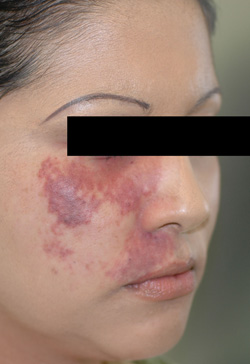
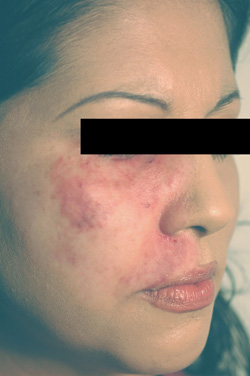
The pictures above were taken of a patient who received six pulsed dye laser treatments for her port wine stain. A series of 8 to 12 was recommended at consultation, and although she didn’t finish the treatment program, as you can see, she had about 75% improvement in the appearance of her facial port wine stain.
If you have a “birthmark” that you’ve always wanted to get rid of, Celibre Medical and class IV medical lasers can help. Birthmarks come in one of two varieties: red or brown. Port wine birthmarks are red in color because they are made up of blood vessels close to the surface of the skin. Another term for this type of mark is a vascular birthmark. Brown birthmarks are darker than your normal skin color. They can range from light tan to very dark brown. These birthmarks are comprised of melanocytes, which are the skin’s pigment (melanin).
Before we describe options for both red and brown birthmarks. It’s important to know that birthmarks are not usually a “one and done” process. Fading of most birthmarks will take several laser treatments for optimal results. In some cases, fading, rather than complete removal, is the end goal.
Class IV medical lasers can safely remove several types of birthmarks on all skin types (colors). Here is a brief list of some of the birthmarks that respond to laser treatment:
These are tan to brown birthmarks that usually appear in infancy. They can range in size from ½” to several inches across, are flat and have the same texture as surrounding skin. Café-au-lait spots can occur anywhere on your body.
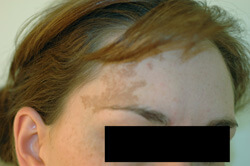
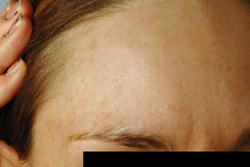
Celibre Laser Birth Mark removal patient
Another pigmented birthmark, Becker’s nevi are often darker in color and larger than café-au-lait spots. They are more common in males, and while they’re often present at birth, people can also develop them in puberty. They generally affect only one side of the body (i.e. are unilateral), and will extend across the chest or shoulder, or down the arm. These birthmarks are more difficult to remove with lasers.

Photo courtesy of Dermnet New Zealand
Nevus of Ota are most commonly found in Asian, Hispanic or African skin types. They often present as dark bluish or greenish patches at the temple forehead or eye, usually only on one side. These birthmarks are successfully treated with high powered q-switched Nd:Yg lasers.
Port wine stains (red, vascular birthmarks) can be small or large, and often involve the facial. The color can range from red to deep purple (hence the name), and they are always present at birth. Pulsed dye lasers are an effective treatment for port wine stains, and can often remove them entirely. Keep in mind, this process may involve several treatments that are spread over a long time period.


Celibre Laser Birth Mark removal patient
Removing birthmarks with lasers can be a delicate and tricky process. No two are alike. Each has its own location, color, shape and size which makes laser treatment of birthmarks a highly-individualized process. Generally, birthmarks are either red or brown, and there are several different types of each. Examples of red or “vascular” birthmarks include port wine stains and hemangiomas. Brown or “pigmented” birthmarks include café-au-lait and nevus of Ota/Ito. The reason it is important to distinguish between these two groups is that they each require different yet specific lasers to treat them effectively.


Red, vascular birthmarks require lasers that target blood vessels, while brown, pigmented birthmarks need lasers that target skin pigment or melanin. It is also important to note that while many of both types of birthmarks can be fully removed using these lasers. Sometimes the best we can do is fade the birthmark so that it’s not so noticeable.
Pulsed dye lasers use technology that targets hemoglobin. Hemoglobin is part of the red blood cell, so it’s a great target if we are trying to get rid of anything that has blood vessels. Vascular birthmarks respond very well to this type of laser. But usually take more treatments over a longer period: 6 to 10 treatments total to see full results. Again, sometimes we can get rid of red birthmarks completely, and other times, the laser fades them a great deal.
Q-switched lasers are the treatment of choice for pigmented or brown birthmarks. Because these contain melanin (skin pigment), they usually fade quickly with the proper treatment. Celibre Medical currently uses two q-switched YAG lasers for these types of spots. We have found that most patients get full results or significant fading after just 3 to 5 treatments with either of our devices. We tell our patients that the sun can stimulate the pigment in the birthmark to return. So heavy, repeated sun exposure of the treated area should be avoided. Q-switched lasers are safe to use on any skin type (color). This is important to know because pigmented birthmarks can be more common in people with darker skin like Hispanics and Asians.
No matter which type of birthmark you have, Celibre has a laser that can safely and effectively remove it. We pride ourselves on being at the forefront of laser medicine and only use the latest, FDA-approved lasers to treat birthmarks. We’ve made sure that we’ve taken extra time and care in choosing our devices so that we can offer treatment to almost anyone with any type of birthmark anywhere on the body. Because of this, we have years of experience in treating a wide array of both types of birthmarks on all skin types. And this is why you can trust Celibre Medical to safely and effectively treat yours as well.
Tattoo removal lasers are powerful devices designed to specifically break apart tattoo ink that was meant to be permanent. While they are both safe and effective in most cases, when used improperly, you can be at risk for unwanted side effects, including scarring.

 If you are having or thinking of having laser tattoo removal, be aware of the possibility of side effects. Choose your laser facility and practitioner carefully to minimize the chances of scarring and make sure you’re treated by someone who is highly experienced. Doing your homework up front to find an experienced practice will limit the risk of scarring.
If you are having or thinking of having laser tattoo removal, be aware of the possibility of side effects. Choose your laser facility and practitioner carefully to minimize the chances of scarring and make sure you’re treated by someone who is highly experienced. Doing your homework up front to find an experienced practice will limit the risk of scarring.
Scarring that can happen after laser tattoo removal generally falls into one of three categories: hypopigmentation (lightening of the skin), hyperpigmentation (darkening of the skin), or textural changes in the skin. Let’s talk a bit more about each of these and why they can happen.
Hypopigmentation after laser tattoo removal is somewhat common – and usually temporary. Remember, the laser works by delivering light energy to the pigment in the tattoo, and often, it is the same wavelength of light that is used to remove excess melanin in the skin. You may see a slight lightening of your natural skin tone where your tattoo was previously and this change often returns to your normal skin color after healing. However, it can be a more permanent change if you’re not taking care of your treated skin with proper sunscreen protection, having your treatments done too close together (without proper healing) or having treatments that are too aggressive (laser energy settings that are too high with bleeding during treatment).
Hyperpigmentation or darkening can also be a common, but is a temporary phenomenon, and is common with darker skin types. Even if your laser practitioner follows all the proper settings and precautions, it can still happen. The best way to avoid this unwanted side effect is to make sure that your laser practitioner is using a tattoo removal device that is right for your skin type (color).
Textural changes in the skin can happen with laser tattoo removal treatments that are done too aggressively. This may include energy settings that are too high for your skin and/or not allowing enough time to properly heal between treatments. Yes, we get it…you want your tattoo gone yesterday, but is it really worth the risk of trading a scar for your tattoo? We’ve seen scars from tattoo removal that look much worse than the original tattoo.
To minimize the risk of improper healing after your laser tattoo removal treatment, follow your practitioners post care guidelines carefully. Make sure you protect your treated skin and tattoo from the sun and keep the area well moisturized while healing.
Finally, make sure that your practitioner is licensed and credentialed to treat you with the device that they are proposing to use for your treatment. As common as laser tattoo removal is, you would be surprised to learn how little training some practices offer prior performing the treatments. Ask lots of questions and be your own advocate. When you do, your chances of having any unwanted side effect or scarring after laser tattoo treatment will be reduced dramatically.
The answer to this question depends largely on what type of acne scars you have. There are several types of acne scars we treat.
Within these categories there are additional variables that determine how we treat acne scars.

 Treating pigmented acne scars is very different than treating textured acne scars. In addition, treating brown acne scars is different than treating red acne scars and treating rolling textured scars is different than treating pinpoint or ice pick textured scars. For pigmented acne scars, there are three options – Pulse dye lasers for red acne scars, q-switched lasers for brown acne scars and depigmentation programs such as Cosmelan and our own proprietary program for getting rid of the brown acne scars without laser treatments.
Treating pigmented acne scars is very different than treating textured acne scars. In addition, treating brown acne scars is different than treating red acne scars and treating rolling textured scars is different than treating pinpoint or ice pick textured scars. For pigmented acne scars, there are three options – Pulse dye lasers for red acne scars, q-switched lasers for brown acne scars and depigmentation programs such as Cosmelan and our own proprietary program for getting rid of the brown acne scars without laser treatments.
For textured acne scars, we have several options including the Aramis and Q-switched lasers (with no downtime) and the Erbium laser for laser resurfacing (5-7 days of social downtime). To determine which type of laser we would recommend for your textured acne scars, we evaluate you in person to see how deep the scars are, what your goals are and what your preference for downtime vs. no downtime procedures is.

